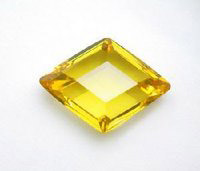Have you learned the crystal naked eye identification technique?
Mainly based on the characteristics of the crystal, more observation, more contrast. Here are some common crystal eye identification techniques. Look at the inclusions: Crystals are produced in nature. Due to environmental reasons, the grown crystals contain cotton wool, cracks or other mineral inclusions. Therefore, in general, when you get a gemstone, use a 10x magnifying glass (10X) to see if it has a natural mineral inclusion or negative crystal. The common inclusions of the crystal are cotton-like or needle-like, as long as you see these things inside. Must be natural crystal. Among them, mineral inclusions are the decisive basis. So what is mineral inclusion? It is a small natural object with a certain shape. Synthetic crystals and glass are generally very clean. White crystal ball, visible impurities and cotton wool, the transparency is not very good. Look at the appearance characteristics For the crystal rough stone, you can observe the gemstone's luster, fracture and surface texture. The crystal is glass luster, shell-like fracture, and the fracture is grease luster. The crystal rough stone is hexagonal prism-shaped, with horizontal stripes or polygonal eclipse on the cylinder surface. If these features are met, the jewel is a crystal, otherwise it is a rough stone or other gems. Astragalus lucidum, with growth lines on the surface, shell-like fractures, and a cross-section of oily luster. The color of natural crystals is generally unevenly distributed, often accompanied by ribbons. Synthetic crystals are formed under relatively stable conditions, and their colors are uniform and uniform, and they are brighter. The color of natural colorless crystals has a smoky tone and feels soft. The synthetic colorless crystal is white and dry, and it is lifeless. Green Ghost Crystal Buddha carvings. The cool natural crystal sticks to the cheeks and feels cold, and the synthetic crystal and glass imitation feels milder. Hardness method If it is a rough stone, the hardness can be scored. Because this is a destructive test, the finished product cannot be used. Use a steel crucible (hardness 6.5 to 7) to scribe the crystal, and then observe whether there is any imprint on the crystal gemstone. If there is no imprint, the Mohs hardness of the gemstone is at least 7. The Mohs hardness of the crystal is 7, and the steel enamel will not leave a mark after the scribe, and if the impression is left, the hardness is less than that of the steel shovel and less than the crystal, it is not a crystal. Line drawing method Draw a line on a piece of white paper (or put a hair), then place the gem on it and observe it through the gem. If the single line becomes a double line, the gem is a non-homogeneous gem, and vice versa. . This is caused by the birefringence of the gemstone, and the glass of the homogenous body has no birefringence, and there is no double shadow phenomenon. If it is a sphere, be sure to turn the sphere to observe, because even if it is a gemstone, there is no birefringence in the direction of the vertical optical axis. Only when it is rotated to other directions, there is birefringence to see the double shadow of the line. In most cases, because of some conditions, such as inlaid finished products, large sculptures, etc., we can't always let us carry out some of the above tests. We need to further determine whether it is natural crystal. In this case, we also need the following instruments. Identification. Men's Suits Men's Suits Guangzhou Hanguang Fashion Co.,Ltd , https://www.aliuniform.com
